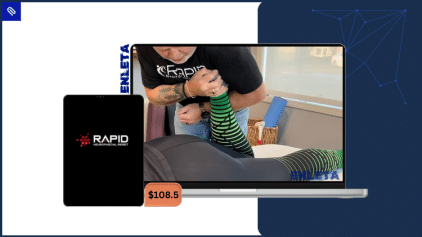Creating Neurological Balance and Ease with David Zemach-Bersin – Instant Download!
Creating Neurological Balance and Ease with David Zemach-Bersin is a self-paced online Feldenkrais® series designed to help participants restore calm, coherence, and resilience in their nervous systems. In response to pervasive stress, anxiety, and chronic muscular tension, the course offers a set of gentle movement exercises, explorations, and embodiment practices aligned with principles of neuroplasticity. The objective is to provide tools that help interrupt habitual tension, prompt nervous system reorganization, and cultivate a sustainable ease of being.
Creating Neurological Balance and Ease with David Zemach-Bersin Free Download – Includes Verified Content:
[FREE WEBINAR] Creating Neurological Balance and Ease with David Zemach-Bersin
Creating Neurological Balance and Ease – Free Download Video Sample:
Creating Neurological Balance and Ease Free Download, Watch content proof here:
PDF Sample – Creating Neurological Balance and Ease, watch here:
Creating Neurological Balance and Ease with David Zemach-Bersin – Overview this course
The series includes six video classes combining talk segments with original Feldenkrais® “Awareness Through Movement” lessons. Participants also get 17 downloadable audio versions of those lessons, six hours of Q&A video content, and bonus recordings on related topics (such as jaw and tongue release, spinal balance, and sensory calmers). Through repeated engagement, the course supports the nervous system in shifting from a chronically sympathetic (fight/flight) state toward a more balanced, adaptive mode where rest, creativity, and regulation can flourish.
Why should you choose this course?
-
Built on a vetted somatic methodology
The Feldenkrais Method® is a well-established approach to learning through movement and nervous system reorganization. This course uses those principles to shift habitual patterns at the neuro-muscular level. -
Addresses modern stress and tension at root
Chronic standing tension, anxiety, poor posture, jaw clenching, shallow breathing—all of which are widespread in contemporary life—are addressed through subtle somatic means rather than aggressive exercise. The course explicitly targets the impact of stress on the nervous system. -
Accessible for all levels
No prior experience with Feldenkrais or movement traditions is required. The lessons are gentle and slow, making them suitable for beginners, while practitioners can still glean subtle refinements. -
Multiple formats and reinforcements
Video + audio + Q&A + bonus modules give diverse access points. You can move with the video, listen during rest, revisit Q&A clarifications, and incorporate bonus lessons as needed. -
Focus on sustainability, not quick fixes
Rather than a one-off workshop, this is a six-week series (self-paced) meant to build a sustainable, embodied recalibration of your nervous system. -
Holistic scope including function, posture, regulation, and embodiment
The course doesn’t just treat symptoms of tension—it works on structural balance, jaw and tongue release, spinal alignment, and integration of sensory regulation so you can feel ease across body, mind, and movement.
If your aim is not just symptom relief but progressive nervous system Re-education, this course offers a coherent, deep path toward long-term balance.
What You’ll Learn
By completing Creating Neurological Balance and Ease, you’ll learn to:
-
Feldenkrais awareness through movement (ATM) principles
Understand how slight, mindful movement can reorganize neural connections and recondition habitual tension. -
Six full classes combining talk + movement
Each class includes a guided movement sequence paired with conceptual commentary to help you internalize why the work matters. -
Audio versions of the movement lessons
17 audio recordings that allow you to practice the movements outside the video format, supporting integration in daily life. -
Q&A clarifications and deeper discussions
Six hours of Q&A videos address common questions, obstacles, and more subtle nuances of practice. -
Bonus recordings on supportive topics
These may include techniques like “Movements of the Jaw and Tongue to Reduce Anxiety,” spinal balancing, and sensory-calm exercises. -
How to interrupt and re-organize habitual tension
Learn to detect where your system has become “stuck” in sympathetic modes and use movement & awareness to shift pathways. -
Techniques for jaw, tongue, and facial release
Because many clients hold tension in those areas, the course offers specific moves to restore ease and reduce secondary strain. -
Embodied breath, support, and posture integration
How to let breathing, spine alignment, and subtle muscular support cohere into a comfortable systemic field. -
Methods to support neuroplastic change over time
Repetition, gentle variation, and gradual challenge are built in so structural reorganization is sustained rather than ephemeral. -
How to track and observe change
Using reflection, body awareness, and noticing shifts in ease, posture, and mental calm. -
Ways to sustain practice beyond the series
Strategies to weave lessons into your daily life so the changes persist rather than regress.
By the end of the program, you should have direct experiential access to a more adaptable, balanced nervous system—not just theory, but felt integration.
Who Should Take This Course?
-
People experiencing chronic tension, anxiety, postural fatigue, or repeated muscular discomfort.
-
Those interested in somatic modalities such as Feldenkrais, Alexander Technique, or yoga but seeking a gentle, nervous system–oriented entry.
-
Individuals with demands on their body and mind (sitting, screen use, repetitive stress) wanting restorative balance.
-
Practitioners in wellness, movement, or therapy professions looking to enrich their somatic toolset.
-
Anyone committed to gentle, sustainable practice rather than aggressive fitness interventions.
-
Students of nervous system science, body awareness, or consciousness work who want to ground insights in embodied practice.
If your approach is purely analytical or you don’t value somatic nuance, some movements may feel subtle. But for those willing to feel with patience and curiosity, it offers rich transformation.
Conclusion
If your intention is to move beyond perpetual tightness, mental tension, and fragmented posture—and to reprogram your nervous system toward balance, restoration, and ease—then Creating Neurological Balance and Ease with David Zemach-Bersin is the precise course to choose. Through six carefully guided classes, supporting audio, Q&A sessions, and bonus modules, you will gradually rewire tension patterns, enliven neural flexibility, release habitual grip, and cultivate a more coherent field of presence. This is not a temporary fix, but a method to inhabit your physiology with more comfort, clarity, and ease.
Creating Neurological Balance and Ease with David Zemach-Bersin is your structured pathway to recalibrate nervous system balance and embody lasting ease.
👍Enroll now and begin bringing nervous balance, gentleness, and coherence into your daily life.










Reviews
There are no reviews yet.